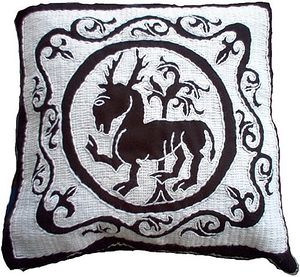Laid and Couched Work: Difference between revisions
No edit summary |
|||
| (3 intermediate revisions by 3 users not shown) | |||
| Line 1: | Line 1: | ||
[[image:Icelandic_finished.jpg|thumb|right|Icelandic Laid and Couched Work Cushion]] |
|||
Is a form of [[embroidery]] where a thread (usually wool) is laid on a ground fabric (usually wool or linen) and then this thread is couched down with another thread. This technique is used to cover large areas of a design very quickly. |
|||
'''Laid and Couched Work''', is a form of [[embroidery]] where a thread (usually [[wool]]) is laid on a ground fabric (usually wool or [[linen]]). This stitch is created by laying a set of ground threads, that work from one side of the pattern to the other. Over these threads, in the opposite direction, are laid another set of threads at regular intervals. These cross threads are then held down by a series of couching stitches. The whole process results in an area completely covered in thread. This technique allows for large areas of pattern to be covered very quickly. |
|||
One of the most famous works completed in this technique is the [[Bayeux Tapestry]]. |
One of the most famous works completed in this technique is the [[Bayeux Tapestry]]. |
||
The image below is of a reproduction design, based on a [[14th century]] [[Iceland]]ic wall hanging. The design below is a cushion and illustrates the laid and couched technique. |
|||
[[category:embroidery]] |
|||
Latest revision as of 12:06, 12 August 2004
Laid and Couched Work, is a form of embroidery where a thread (usually wool) is laid on a ground fabric (usually wool or linen). This stitch is created by laying a set of ground threads, that work from one side of the pattern to the other. Over these threads, in the opposite direction, are laid another set of threads at regular intervals. These cross threads are then held down by a series of couching stitches. The whole process results in an area completely covered in thread. This technique allows for large areas of pattern to be covered very quickly.
One of the most famous works completed in this technique is the Bayeux Tapestry.
The image below is of a reproduction design, based on a 14th century Icelandic wall hanging. The design below is a cushion and illustrates the laid and couched technique.
